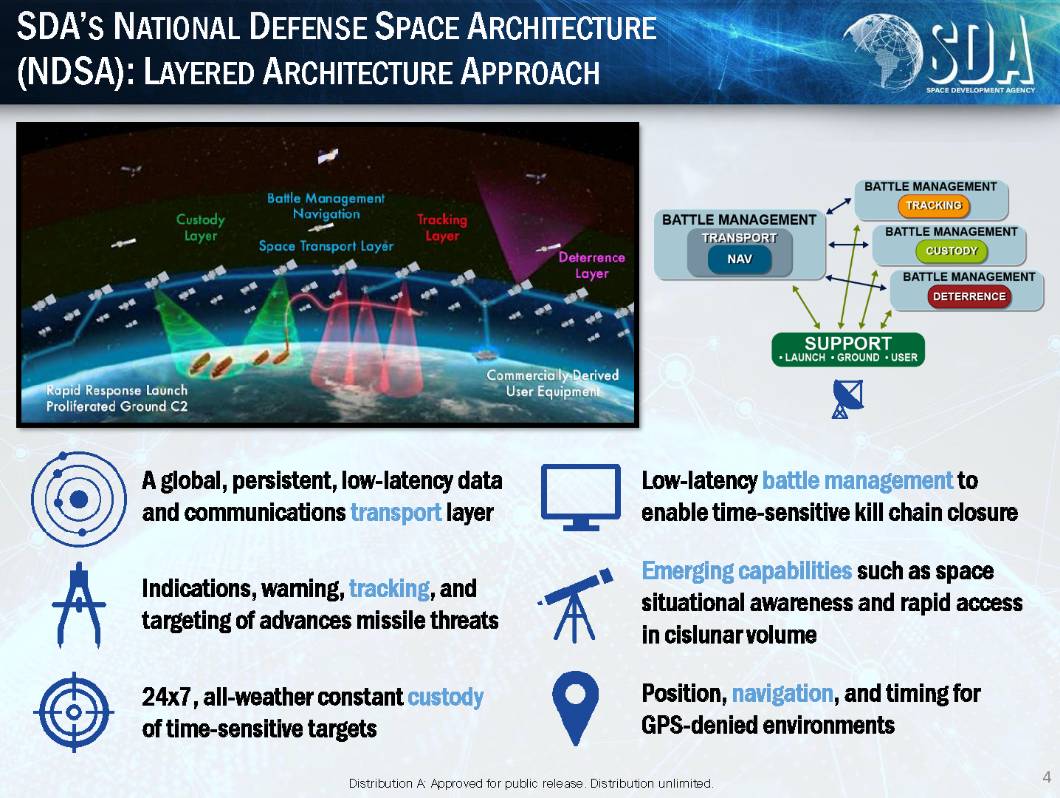 Director of the U.S. Space Force’s Space Development Agency Derek Tournear speaks to reporters at the Space Symposium in Colorado Springs, Col., April 10, 2024. (Source: Space Foundation)
Director of the U.S. Space Force’s Space Development Agency Derek Tournear speaks to reporters at the Space Symposium in Colorado Springs, Col., April 10, 2024. (Source: Space Foundation)
WASHINGTON – The U.S. Department of Defense has big ambitions for space, and making those plans a reality will depend on its ability to harness emerging data management and analysis technologies, including automation and edge computing, with artificial intelligence (AI) as a key enabler for both, according to experts.
The U.S. Space Development Agency (SDA), for example, has deployed the first iteration, or Tranche 0, of its planned Proliferated Warfighter Space Architecture (PWSA), which ultimately will consist of hundreds of satellites in different non-geostationary orbits that not only identify and monitor ground and airborne threats but also deliver precise targeting information to the shooters that will take them out. Meanwhile, the U.S. Space Force and National Reconnaissance Office (NRO) are collaborating on a global satellite constellation for ground moving target indication, a long-sought capability that, like the PWSA, entails collecting and sifting through massive amounts of data to produce actionable information in near-real time.
Integrating AI into Military Constellations
In a keynote address to the Satellite 2024 conference, SDA Director Derek Tournear offered a sense of the PWSA challenge:
“We’re concerned with the terrestrial fight and giving space-based capabilities to provide two capabilities: the first is beyond line of sight targeting for time-sensitive targets, ships and mobile launchers – detect them, track them, calculate a firing solution and send that down directly to a shooter as rapidly as possible,” Tournear said. “The second capability is the same thing except now … I’m looking at advanced hypersonic glide vehicles and advanced missiles in flight – detect, track calculate a firing solution and send that directly down to an interceptor as quickly as possible.”
The PWSA features a Tracking Layer that will detect and track targets and send that information via laser links to the Transport Layer for relay to the ground, all at the speed of modern warfare. Along the way, the data gets confirmed by other sensors and excised of noise – superfluous data that sensors inevitably collect – lest the system become overwhelmed.
As the PWSA evolves, AI and machine learning will play an increasingly important role, particularly in automated network management, Tournear told reporters at the Space Symposium in Colorado Springs this week.
“We don’t foresee that immediately [we’ll be] using a lot of AI to actually do a lot of the satellite flying and controlling, because that’s pretty standard and can be done even at the several hundred satellites,” he said. “But the mesh network—when you have several connectivity points to each one—we’re going to need a lot of AI to be able to handle that efficiently.”
The PWSA’s first operational satellites, Tranche 1, slated to launch starting late this year, will rely on “manually intensive” ground-based processing to for intelligent routing, Tournear said in response to a question from Constellations.
“In the future, starting with Tranche 2 and certainly in Tranche 3, we want all that to be done autonomously” using onboard battle management command and control (BMC3) processors, Tournear said. “So, the rerouting and the calculating of best paths will be done all autonomously onboard and there are going to be a lot of AI aspects in managing that complicated mesh network,” he said.
 The Proliferated Warfighter Space Architecture concept. (Source: SDA)
The Proliferated Warfighter Space Architecture concept. (Source: SDA)
In a speech at the recent Space Symposium, Heidi Shyu, U.S. Undersecretary of Defense for Research and Engineering, offered a glimpse at how the Pentagon intends to leverage AI and automation to control and enhance the capabilities of its satellites more generally.
“AI and machine learning will continue to grow in importance since they provide accelerated capabilities to turn data into intelligence,” Shyu said. “AI and [machine learning] will significantly reduce an operator’s workload.”
A Task Too Big and Complex for Humans
Experts generally agree that humans are incapable of orchestrating at the scale of DoD’s planned mega-constellations. To make it all work, there must be a large degree of automation.
“With these many assets and these complex tasks, you cannot really do it with humans in the loop,” William Joo, Special Projects Engineer and Science & Technology Assistant Program manager for U.S. Naval Information Warfare Systems Command, said during a recent panel discussion.
Edge computing, the ability to process all that data in space so that ideally, only actionable information gets delivered to the shooters, also is key.
“We need to be able to look at how much of this processing do we do at the edge versus how much of this processing we do in the command center or other places,” Aslan Tricha, Vice President of Automation & Orchestration at smart terminal maker ALL.SPACE, said during a discussion on AI in military space. Sending raw data to a command center for processing is possible but costs valuable time, he said.
AI and Automation
As satellite architectures and missions become more complex, AI will increasingly come into the mix. But specifics are difficult to pin down.
Part of the problem is the term AI often means different things to different people. Some people mistakenly use the terms AI and automation interchangeably, Cuadra said. “There should be a lot more rigor associated with that.”
Scott Herman, chief product officer at Maxar Intelligence, said AI is very broad area that includes multiple computing techniques. “The key thing that differentiates AI from compute is AI is using a category of techniques that are about improving the more you use them; it gets better as it goes.”
In a brief interview with Constellations, Herman emphasized that AI is a means to an end, rather than an end itself.
“Automated [data] exploitation is the end result; AI is a horizontal technology that can be applied to that problem, just like lots of other technologies can be applied,” Herman said. “AI will take an increasingly important role because of its ability to operate at scale...”
As if to illustrate that point, a PWSA technology roadmap published on the SDA’s website does not specifically mention AI. But it does mention capabilities like “onboard automatic target recognition” and “automated optimization and tasking,” which enter the picture starting around the end of the decade and likely will require some level of AI.
While Increasingly Important, AI is No Panacea
For all the recent talk and excitement surrounding AI, experts point out that this technology is not poised to change the world overnight.
“What the media tells us about AI and all of this growth – all of that is fascinating,” Tricha said. “But I think in the field, you’ll have a lot more constraints … So, you’re going to have to deploy it in very tiny models, or models that have been trained to do very, very specific things.”
Herman said AI, while instrumental, is not the answer to everything, and that more traditional data processing techniques will continue to have a role. So will humans, if only to monitor and assess whether AI algorithms are doing their job correctly, he added.
Going a step further, Herman said AI is not necessarily the pacing item as the Pentagon moves toward large, connected and highly responsive satellite constellations for global battlespace awareness and precision targeting. “It’s going to be how do you build these sensor networks and deploy them, how you build your concepts of operation and how do you do the implementation of all the mission parameters and rules,” he said. “I don’t think we’re waiting for a giant breakthrough in AI for this stuff to work.”
Leandra Bernstein contributed to this article from Colorado Springs, Col.
Explore More:
Podcast with Col. Michael Christensen: Playing Poker, Changing Mindsets and Space Superiority
SDA Expected to Release Results of Optical Comms Tests
DoD’s Multilayered Space Network Focuses on Interoperability Challenges
Space Development Agency Drives Disruptive Acquisition
